-
10-17-2022
Campaña de Vacunación contra el COVID-19: Infodemia de Fake News
Revista Brasileira de Enfermagem. 2022;75(4):e750401
Abstract
Campaña de Vacunación contra el COVID-19: Infodemia de Fake News
Revista Brasileira de Enfermagem. 2022;75(4):e750401
DOI 10.1590/0034-7167.2022750401pt
Views0A globalização atingiu o século XXI na mesma sintonia e disseminação que as redes sociais, assemelhada ou correlata do mundo digital/virtual como fonte de informação e aconselhamento sobre a saúde pública brasileira e internacional. Logo, as pessoas contaminaram o processo de comunicação cibernético com diversas informações, verdadeiras e/ou falsas, provocando o que se denomina hodiernamente […]See more -
ORIGINAL ARTICLE10-17-2022
Support provided to nursing students in the face of patient safety incidents: a qualitative study
Revista Brasileira de Enfermagem. 2022;75(2):e20220009
Abstract
ORIGINAL ARTICLESupport provided to nursing students in the face of patient safety incidents: a qualitative study
Revista Brasileira de Enfermagem. 2022;75(2):e20220009
DOI 10.1590/0034-7167-2022-0009
Views0See moreABSTRACT
Objectives:
to identify the support provided to nursing students after a patient safety incident.
Methods:
qualitative study developed with 23 students attending an undergraduate nursing program in southern Brazil. Data were collected between September and November 2021 and submitted to textual discursive analysis using the Iramuteq software.
Results:
the students reported that mainly classmates and professors of the practical courses provided support. The students showed no knowledge of organizational support or protocols available to students who become second victims of such incidents.
Final Considerations:
the primary support sources available to nursing students involved in patient safety incidents were identified. Note that support provided to nursing students is still incipient both in Brazil and internationally. Hence, further studies are needed to address potential victims and support resources to mitigate this phenomenon.
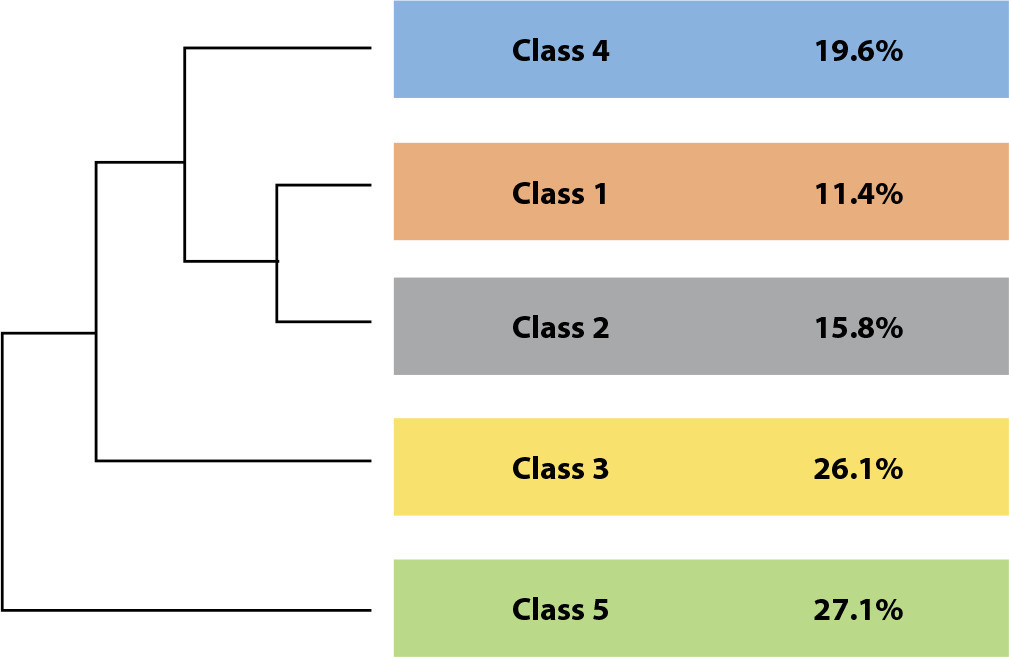
-
ORIGINAL ARTICLE10-17-2022
Supervision of the professional practice of nursing: case study describing the “on-site inspection” sub-process
Revista Brasileira de Enfermagem. 2022;75(2):e20210823
Abstract
ORIGINAL ARTICLESupervision of the professional practice of nursing: case study describing the “on-site inspection” sub-process
Revista Brasileira de Enfermagem. 2022;75(2):e20210823
DOI 10.1590/0034-7167-2021-0823
Views0See moreABSTRACT
Objectives:
to describe the “On-site inspection” sub-process of the macroprocess “Supervision” conducted at the headquarters unit of the Regional Nursing Council of São Paulo.
Methods:
an exploratory descriptive research, in a single case study modality using data reported by the Headquarters Unit Inspection Management leaders.
Results:
the description of the “On-Site inspection” sub-process, initial and return, showed how the activities/tasks pre-established in the inspection roadmap and inserted in the respective inspection terms need to be accurately and sequentially executed to comply with the current legislation and provided the identification of activities that add value to the inspection process.
Conclusions:
the results obtained give visibility to the activities/tasks developed by the inspectors and will provide the Inspection Management with subsidies for the rational allocation of the required human resources; and, to the technical managers and legal representatives of the inspected institutions, the knowledge of the activities developed during the performance of the sub-process “On-site inspection”.
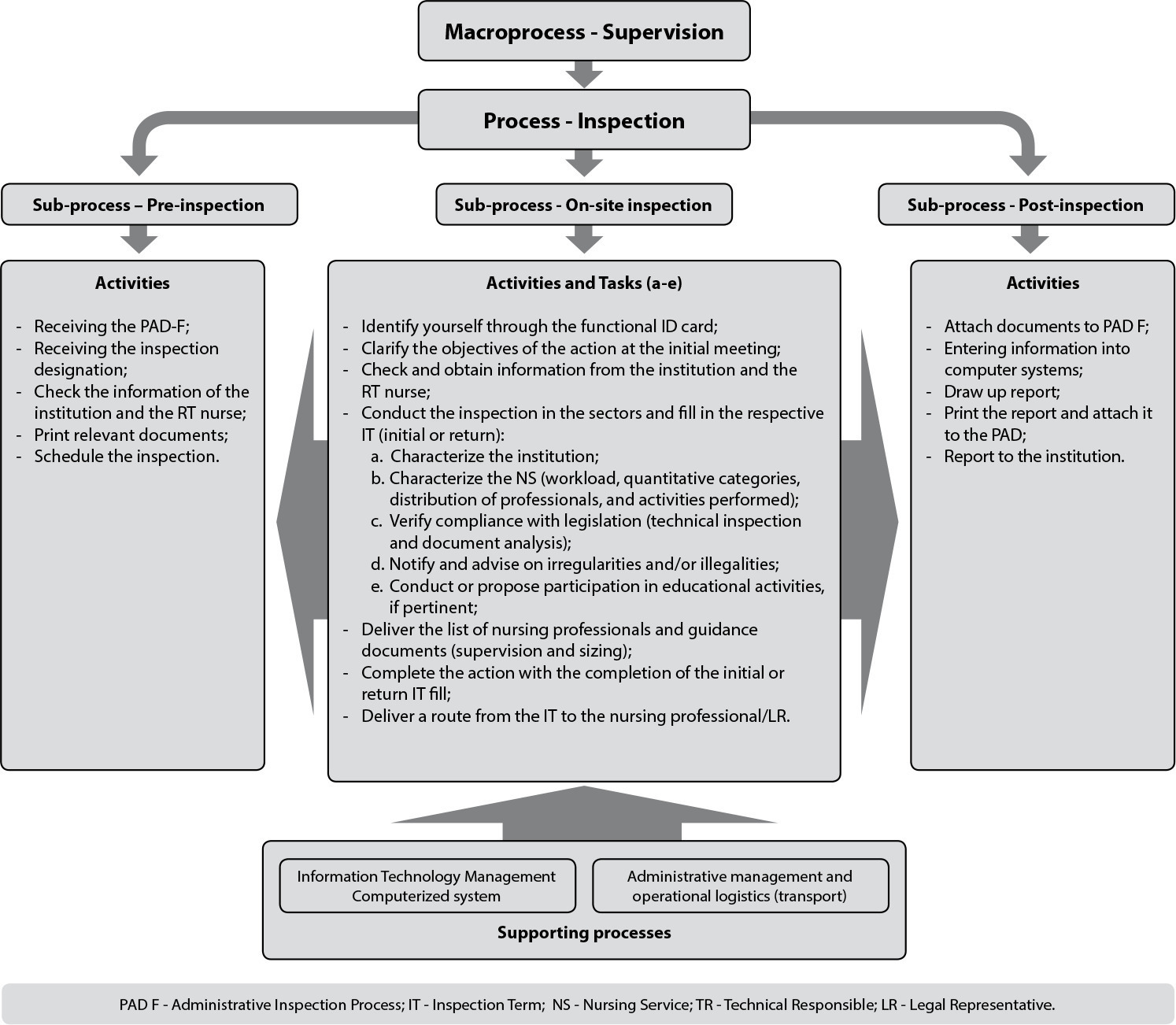
-
REVIEW10-17-2022
Authentic leadership in nurses’ professional practice: an integrative review
Revista Brasileira de Enfermagem. 2022;75(1):e20210972
Abstract
REVIEWAuthentic leadership in nurses’ professional practice: an integrative review
Revista Brasileira de Enfermagem. 2022;75(1):e20210972
DOI 10.1590/0034-7167-2021-0972
Views0See moreABSTRACT
Objectives:
to identify the primary constructs concerning authentic leadership and its relevance for nurses’ professional practice.
Methods:
integrative literature review conducted between 2015 and 2020 in LILACS, SciELO, and PubMed databases.
Results:
the United States published most of the 31 studies analyzed, with eight studies (25.8%), followed by Canada with seven studies (22.6%), and Brasil with five (16.1%). Most studies adopted a quantitative approach (77.41%), and 96.8% presented weak evidence. Three categories emerged: Work Engagement/Job Satisfaction and Organizational Commitment; Healthy Work Environment; and Intention to Quit the Job and Mental Exhaustion.
Final Considerations:
authentic leadership positively contributes to management and nursing care practice, promoting healthy work environments, structural empowerment, greater work engagement, and organizational commitment, decreasing absenteeism and mental exhaustion.
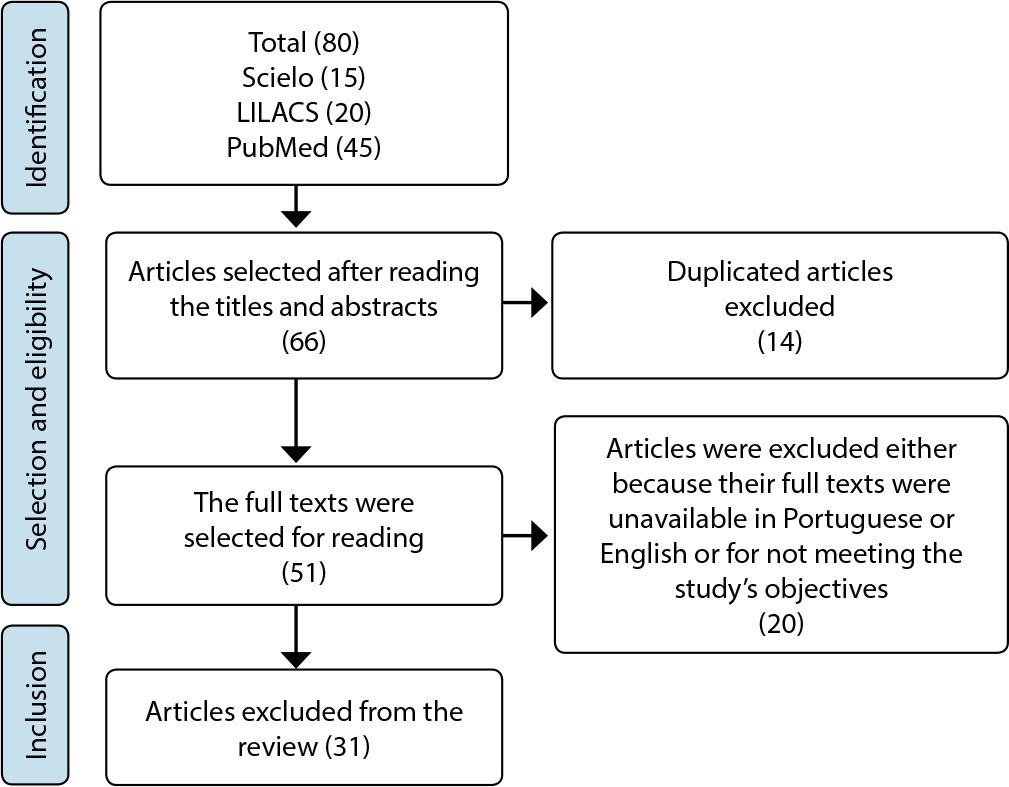
-
ORIGINAL ARTICLE10-17-2022
Factors associated with psychoactive substance use among professional truck drivers
Revista Brasileira de Enfermagem. 2022;75:e20210187
Abstract
ORIGINAL ARTICLEFactors associated with psychoactive substance use among professional truck drivers
Revista Brasileira de Enfermagem. 2022;75:e20210187
DOI 10.1590/0034-7167-2021-0187
Views0See moreABSTRACT
Objectives:
to identify factors associated with the use of psychoactive substances among professional truck drivers.
Methods:
cross-sectional study that investigated the use of at least one psychoactive substance and its association with sociodemographic, occupational, and health characteristics in 354 professional truck drivers. Researchers collected data through face-to-face interviews using forms. Multiple regression analyzes estimated prevalence ratios (PR) and respective 95% confidence intervals (95%CI).
Results:
lower family income (PR: 2.03; 95%CI: 1.08-3.83), symptoms of insomnia (PR: 2.18, 95%CI: 1.46-3.26), and long working hours (PR: 1.95, 95%CI: 1.30-2.92) independently associated with the use of at least one psychoactive substance.
Conclusions:
a set of sociodemographic, occupational, and health variables acts at distinct levels and is independently associated with the use of psychoactive substances among professional truck drivers.
-
ORIGINAL ARTICLE10-17-2022
Coping with the health condition from the perspective of people with HIV who abandoned treatment
Revista Brasileira de Enfermagem. 2022;75:e20210958
Abstract
ORIGINAL ARTICLECoping with the health condition from the perspective of people with HIV who abandoned treatment
Revista Brasileira de Enfermagem. 2022;75:e20210958
DOI 10.1590/0034-7167-2021-0958
Views0See moreABSTRACT
Objectives:
to understand how people living with HIV who have abandoned treatment face their health condition.
Methods:
a qualitative study, based on the Chronic Care Model theoretical precepts. Data were collected between April and August 2021, through interviews with 24 people registered in a specialized service in the Brazilian Midwest.
Results:
coping with the health condition included good and bad moments and is influenced by individual behaviors and the way in which the network was organized. Treatment abandonment was motivated by the absence of signs and symptoms, the way care is provided and medication side effects.
Final Considerations:
care actions focusing on behavior change and maintenance become necessary in order to favor continuity of treatment. Furthermore, the gaps identified in the way health services are organized are subject to intervention.
-
ORIGINAL ARTICLE10-17-2022
Ethics, COVID-19 and nursing vulnerability: analysis of photographs released by the media
Revista Brasileira de Enfermagem. 2022;75:e20210960
Abstract
ORIGINAL ARTICLEEthics, COVID-19 and nursing vulnerability: analysis of photographs released by the media
Revista Brasileira de Enfermagem. 2022;75:e20210960
DOI 10.1590/0034-7167-2021-0960
Views1See moreABSTRACT
Objectives:
to analyze nursing vulnerability through photos released by the media amidst the COVID-19 pandemic.
Methods:
a documentary study, with a qualitative approach. The object of analysis were photographic images selected between January 2020 and March 2021, published by the main news portals in countries such as Brazil, the United States, France, Spain, England and Germany. Thematic categorical analysis was the method of analysis used.
Results:
we found 74 photographs that portrayed nursing professionals in different work situations. It was possible to identify stigma and social devaluation about this class’s representation and professional attribution. Moreover, we found an underrepresentation of black professionals in Brazilian portals and the man as the prominent figure in the spaces of claims.
Final Considerations:
the photographs represented an important tool for the social analysis of nursing vulnerability, favoring the unveiling of situations that may go unnoticed by nursing and society.
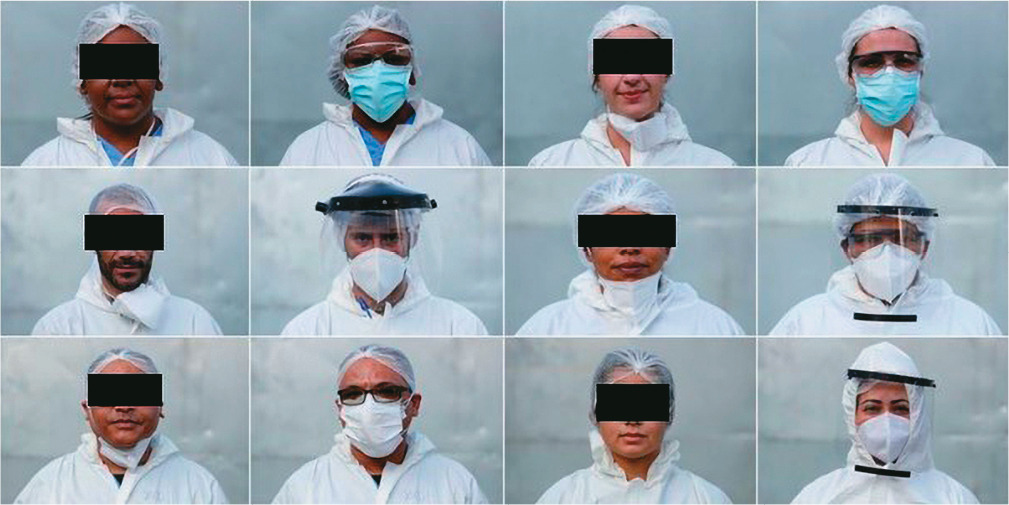
-
ORIGINAL ARTICLE10-17-2022
Association between rural workers’ sociodemographic and reproductive characteristics and their reproductive autonomy
Revista Brasileira de Enfermagem. 2022;75:e20210878
Abstract
ORIGINAL ARTICLEAssociation between rural workers’ sociodemographic and reproductive characteristics and their reproductive autonomy
Revista Brasileira de Enfermagem. 2022;75:e20210878
DOI 10.1590/0034-7167-2021-0878
Views0See moreABSTRACT
Objectives:
to verify the association between sociodemographic and reproductive characteristics with rural workers’ reproductive autonomy.
Methods:
a cross-sectional study, with a sample of 346 women and application of the Reproductive Autonomy Scale. Multinomial regression was performed to analyze associations between independent variables and outcomes.
Results:
in the analysis of subscales “Decision-making”, “My sexual partner or someone else such as a parent”, “Both me and my partner” and “Me”, women experienced greater reproductive autonomy in relation to their partners. For outcomes “Decision about which method to use”, “When to have a baby” or “About unplanned pregnancy”, the highest prevalence was for category “Me”, with statistically significant associations.
Conclusions:
the sociodemographic and reproductive characteristics among the most vulnerable women, in terms of the social, economic and cultural context in which they are inserted, may be associated with greater difficulties in exercising reproductive autonomy.
-
RESEARCH01-01-2018
Assistance flowchart for pain management in a Neonatal Intensive Care Unit
Revista Brasileira de Enfermagem. 2018;71:1281-1289
Abstract
RESEARCHAssistance flowchart for pain management in a Neonatal Intensive Care Unit
Revista Brasileira de Enfermagem. 2018;71:1281-1289
DOI 10.1590/0034-7167-2017-0265
Views0See moreABSTRACT
Objective:
To describe and discuss the process of developing a flowchart collectively constructed by the health team of a Neonatal Intensive Care Unit for the management of neonatal pain.
Method:
This is a descriptive and an exploratory study with a qualitative approach that used Problem-Based Learning as a theoretical-methodological framework in the process of developing the assistance flowchart for the management of neonatal pain.
Results:
Based on this methodology, there was training in service and the discussion of key points of pain management by the health team, which served as input for the construction of the flowchart.
Final considerations:
The assistance flowchart for pain management, based on scientific evidence, provided means to facilitate the decision-making of the health team regarding the pain of the newborn. It is suggested to use the flowchart frequently to promote the permanent education of the team and identify possible points to be adjusted.
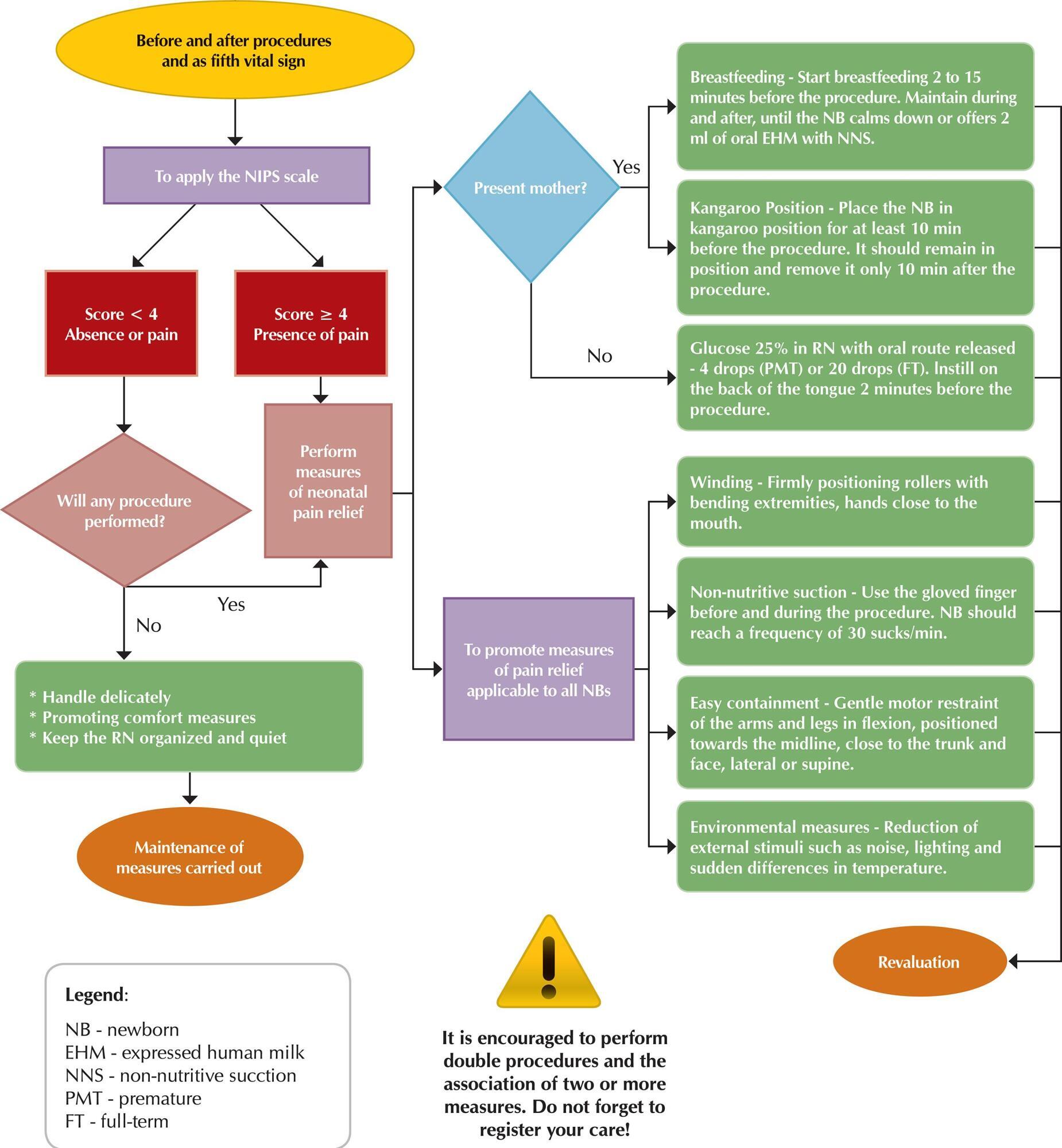
-
RESEARCH01-01-2018
The adolescent and the institutionalization: understanding the phenomenon and meanings attributed to it
Revista Brasileira de Enfermagem. 2018;71:1373-1380
Abstract
RESEARCHThe adolescent and the institutionalization: understanding the phenomenon and meanings attributed to it
Revista Brasileira de Enfermagem. 2018;71:1373-1380
DOI 10.1590/0034-7167-2017-0242
Views1See moreABSTRACT
Objective:
To understand the meaning of being institutionalized and in conflict with the law for the institutionalized adolescent.
Method:
A qualitative, phenomenological-comprehensive study carried out in a Socio-educational Service Foundation in the northern region of Brazil, with 05 institutionalized adolescents. The analysis was carried out under the understanding of the content suggested by Heidgger, thus allowing the construction of analytical categories for a hermeneutical interpretation.
Results:
Conflicting with the law means something negative and bad for the institutionalized adolescents, in which they understand that although there is deprivation of liberty, the period of hospitalization is an important moment for the reflection on the need to start over.
Conclusion:
The meaning of conflicting with the law goes far beyond a simple word, act or behaviour, it is something that only those who experience the phenomenon are able to unveil, arouse deep feelings and provide reflection to the adolescent about the damages caused by the infraction.
-
RESEARCH01-01-2018
Identification of post-cesarean surgical site infection: nursing consultation
Revista Brasileira de Enfermagem. 2018;71:1395-1403
Abstract
RESEARCHIdentification of post-cesarean surgical site infection: nursing consultation
Revista Brasileira de Enfermagem. 2018;71:1395-1403
DOI 10.1590/0034-7167-2017-0325
Views0See moreABSTRACT
Objective:
To describe the profile of women in relation to their living conditions, health status and socio-demographic profile, correlating it with the presence of signs and symptoms suggestive of post-cesarean surgical site infection, identifying information to be considered in the puerperium consultation performed by nurses and proposing a roadmap for the systematization of care.
Method:
Quantitative, exploratory, descriptive, cross-sectional and retrospective review of medical records of women who had cesarean deliveries in 2014, in the city of São Paulo.
Results:
89 medical records were analyzed, 62 of them with incomplete information. In 11, there was at least one of the signs and symptoms suggestive of infection.
Conclusion:
Given the results of the study, the systematization of puerperal consultation is essential. The roadmap is an instrument that can potentially improve the quality of service and the recording of information.
-
RESEARCH01-01-2018
Nursing laboratory and critical education of nurses: approaches and distances
Revista Brasileira de Enfermagem. 2018;71:1500-1506
Abstract
RESEARCHNursing laboratory and critical education of nurses: approaches and distances
Revista Brasileira de Enfermagem. 2018;71:1500-1506
DOI 10.1590/0034-7167-2017-0339
Views1See moreABSTRACT
Objective:
to analyze the contribution of the laboratory of nursing to the critical education of nurses.
Method:
qualitative study, conducted among 18 professors of higher education institutions, being one public and the other private. Data were collected between February and November of 2016 by means of semi-structured interview. To analyze data, it was used a content analysis in the thematic modality.
Results:
it was observed the emphasis in the technical skills development by propagation of behavior and practices; the creation of bonds between professors and students happens on the limit of good interpersonal relationship; the laboratory of nursing may help the critical reflection about the practice, being a place that allows the learning of ethics.
Final considerations:
the nurse education, carried out by the laboratory of nursing, have to overcome the emphasis in the uncritical reproduction of practices and to observe the nurse’s power to think about the reality in the meaning of its modification.
-
RESEARCH01-01-2018
Introduction of the School Health Program in the city of Cascavel, Paraná State: report of nurses
Revista Brasileira de Enfermagem. 2018;71:1540-1547
Abstract
RESEARCHIntroduction of the School Health Program in the city of Cascavel, Paraná State: report of nurses
Revista Brasileira de Enfermagem. 2018;71:1540-1547
DOI 10.1590/0034-7167-2017-0188
Views1See moreABSTRACT
Objective:
to understand the introduction of the School Health Program in the city of Cascavel, Paraná State, as opposed to the report of nurses.
Method:
a qualitative study with fifteen participants. The data were collected from April to August 2015, through semi-structured interviews, analyzed by content analysis and thematic modality.
Results:
the category “Introduction process” of the School Health Program integrates the subcategories “Identified health problems” and the “Challenges of intersectoriality”. The program was implemented quickly, with a fragile training of professionals to perform in the phases that compose it. Structural conditions of schools, human and material resources, and emerging intersectoral interaction were identified obstacles. The integration of the health, school, and family constitutes the program’s potentiality.
Final considerations:
it is understood that the actions of the program were based on health assessments of students, and it is necessary for professionals and managers to discuss and analyze the obstacles identified to achieve all the proposed objectives.
-
RESEARCH01-01-2018
Knowledge about precautions in Primary Health Care: tool validation
Revista Brasileira de Enfermagem. 2018;71:1589-1595
Abstract
RESEARCHKnowledge about precautions in Primary Health Care: tool validation
Revista Brasileira de Enfermagem. 2018;71:1589-1595
DOI 10.1590/0034-7167-2017-0886
Views0See moreABSTRACT
Objective:
To elaborate and validate a tool to assess knowledge and behavior of nursing professionals about standards and specific precautions in the Primary Health Care.
Method:
Methodological study of the elaboration and validation of the tool by thirteen experts judges, using a Likert scale of 4 points, with Content Validity Index ≥ 0.80, on clarity, relevance and pertinence.
Results:
A tool composed of 47 dichotomous questions to assess knowledge and 12 questions, with five options of answers, for the referred behavior. In the validation, only one item was deleted, related to the “Hands Hygiene” axis and one item was reformulated, regarding “Use of Common Gloves” and another 11 changed writing. The tool as a whole was assessed for relevance, comprehensiveness and representativeness within the scope of the topic investigated.
Conclusion:
The developed tool has been validated and is now available for use in Primary Health Care.
-
RESEARCH01-01-2018
Training in diabetes education: meanings attributed by primary care nurses
Revista Brasileira de Enfermagem. 2018;71:1611-1618
Abstract
RESEARCHTraining in diabetes education: meanings attributed by primary care nurses
Revista Brasileira de Enfermagem. 2018;71:1611-1618
DOI 10.1590/0034-7167-2017-0792
Views1See moreABSTRACT
Objective:
seize meanings attributed by primary care nurses to training in diabetes education.
Method:
exploratory and descriptive study, with a qualitative approach, with twenty primary care nurses; semistructured interview script, with interviews processed in the IRaMuTeQ software and analyzed through the Descending Hierarchical Classification. The results were subsidized in the Representational Theory of Meaning.
Results:
nurse training in diabetes education is insufficient for holistic action, although it allows the community to be instrumentalized in specific issues about the disease, using the limited tools available, especially lectures. Nurses find themselves in a context of challenges, improvisations, weaknesses, and limitations that determine the meaning attributed to diabetes education and subsequent actions.
Conclusion:
the meanings attributed by the nurses revealed an incipient training, which limits the quality of care provided and instigates the search for qualification.

-
RESEARCH01-01-2018
Nursing international student mobility in the University of São Paulo
Revista Brasileira de Enfermagem. 2018;71:1619-1625
Abstract
RESEARCHNursing international student mobility in the University of São Paulo
Revista Brasileira de Enfermagem. 2018;71:1619-1625
DOI 10.1590/0034-7167-2017-0754
Views1See moreABSTRACT
Objective:
To characterize the experiences of undergraduate students of the School of Nursing of the University of São Paulo (EEUSP) who participated in international mobility programs between January 2011 and July 2017.
Method:
Exploratory, descriptive study with quantitative approach. Of 68 reports, only 38 (56%) were considered valid and were submitted to descriptive statistical analysis. Data were categorized in general, institutional, academic and cultural aspects and cost of living.
Results:
The main destination was Portugal and the years with most participation were 2012 and 2013. The mean stay was six months and the students took a mean of three to four courses. The main funder was the university of origin.
Conclusion:
Academic activities were limited to theoretical and practical courses, with little insertion in research. There is a need to increase investment in learning other languages and to expand partnerships with larger centers of foreign education and research.
-
ORIGINAL ARTICLE07-13-2020
Mental health of nursing in coping with COVID-19 at a regional university hospital
Revista Brasileira de Enfermagem. 2020;73:e20200434
Abstract
ORIGINAL ARTICLEMental health of nursing in coping with COVID-19 at a regional university hospital
Revista Brasileira de Enfermagem. 2020;73:e20200434
DOI 10.1590/0034-7167-2020-0434
Views0See moreABSTRACT
Objective:
to identify prevalence and factors associated with anxiety and depression in nursing professionals who work to cope with COVID-19 at a university hospital.
Methods:
a cross-sectional observational study using a sociodemographic questionnaire and Hospital Anxiety and Depression Scale, with 88 nursing professionals. Data were analyzed using absolute and relative frequency and Statistical Package for the Social Sciences.
Results:
there was prevalence of anxiety (48.9%) and depression (25%). The majority of the sample consisted of women over 40 years old, married or in a common-law marriage, white, with higher education or graduate degree, with an income above 3,000.00 reais, public servants, working 40 hours a week and working in the hospital from 1 to 5 years.
Conclusion:
we must consider the impact on mental health nursing caused by COVID-19 and intervene with coping strategies to minimize the suffering of professionals.
-
REFLECTION04-22-2020
Thematic content analysis using ATLAS.ti software: Potentialities for researchs in health
Revista Brasileira de Enfermagem. 2020;73(3):e20190250
Abstract
REFLECTIONThematic content analysis using ATLAS.ti software: Potentialities for researchs in health
Revista Brasileira de Enfermagem. 2020;73(3):e20190250
DOI 10.1590/0034-7167-2019-0250
Views0See moreABSTRACT
Objective:
to describe the most important tools of ATLAS.ti Software and to associate them with the procedures of Thematic Content Analysis.
Method:
It is a theoretical reflection of the Content Analysis phases of Laurence Bardin, associating them with software tools Atlas.ti and showing its usefulness for data analysis in qualitative research.
Results:
historical contextualization and the available resources of Atlas.ti software with presentation of health research involving the phases of thematic content analysis.
Final considerations:
The Atlas.ti software assists in the accomplishment of the thematic content analysis being this promising association in health research.

-
REFLECTION10-26-2020
Nursing education: challenges and perspectives in times of the COVID-19 pandemic
Revista Brasileira de Enfermagem. 2020;73:e20200683
Abstract
REFLECTIONNursing education: challenges and perspectives in times of the COVID-19 pandemic
Revista Brasileira de Enfermagem. 2020;73:e20200683
DOI 10.1590/0034-7167-2020-0683
Views0See moreABSTRACT
Objective:
To discuss the challenges and perspectives of nursing education in times of the COVID-19 pandemic.
Methods:
Reflection study, with theoretical approach based on national and international publications, allied to the experience of researchers in the area of nursing education.
Results:
Four sections are identified: Nursing education: current affairs and perspectives; Education and technologies in time of pandemic: acceleration, alteration and paralysis; Difference between emergency, intentional and remote teaching; the return to the “new normality”: new structuring axes and legal norms.
Final considerations:
The conclusion is that longstanding challenges have emerged with the pandemic, and the processes of acceleration, change and paralysis have marked education in these times. Moreover, epidemiological, technological and psychological aspects should be more valued in the return to activities.
-
ORIGINAL ARTICLE11-13-2020
Social determinants of health and COVID-19 infection in Brazil: an analysis of the pandemic
Revista Brasileira de Enfermagem. 2020;73:e20200673
Abstract
ORIGINAL ARTICLESocial determinants of health and COVID-19 infection in Brazil: an analysis of the pandemic
Revista Brasileira de Enfermagem. 2020;73:e20200673
DOI 10.1590/0034-7167-2020-0673
Views0See moreABSTRACT
Objective:
To analyze the influence of socioeconomic, demographic, epidemiological factors, and the health system structure in the evolution of the COVID-19 pandemic in Brazil.
Methods:
Ecological study with variables extracted from databases, having the incidence and mortality by COVID-19 until August 23, 2020, in Brazilian states, as response variables. The magnitude of the associations was estimated using Spearman’s correlation coefficient and multiple regression analysis.
Results:
In the Brazilian states, 59.8% of variation in the incidence of COVID-19 was justified by income inequality, significant home densification, and higher mortality. In the case of mortality, those same variables explained 57.9% of the country’s variations in federal units.
Conclusion:
Our results indicate that socioeconomic factors influenced the evolution and impact of COVID-19 in Brazil. Thus, we suggest comprehensive actions to ensure economic conditions and strengthening of health networks for populations with socioeconomic vulnerability.
-
ORIGINAL ARTICLE02-27-2020
Prevalence of symptoms and quality of life of cancer patients
Revista Brasileira de Enfermagem. 2020;73(2):e20180287
Abstract
ORIGINAL ARTICLEPrevalence of symptoms and quality of life of cancer patients
Revista Brasileira de Enfermagem. 2020;73(2):e20180287
DOI 10.1590/0034-7167-2018-0287
Views0See moreABSTRACT
Objectives:
to analyze the prevalence of symptoms and their relationship with the quality of life of cancer patients.
Methods:
this is a cross-sectional study with 107 patients evaluated using a sociodemographic instrument, the hospital anxiety and depression scale (HADS) and the quality of life scale (EORTC-QLQ-C30). Pearson’s correlation test was used to evaluate the relationship between symptoms and quality of life.
Results:
prevalence of female patients (56.1%), 55 years as the mean age and 10 years of schooling. Fatigue (76.6%), insomnia (47.7%), pain (42.1%), loss of appetite (37.4%), anxiety (31.8%) and depression (21.5%) were identified. Anxiety and depression symptoms presented a negative correlation with quality of life and positive correlation with physical symptoms.
Conclusions:
fatigue, insomnia, pain and loss of appetite were the most common and most intense symptoms. Anxiety and depression symptoms presented a negative correlation with quality of life and positive correlation with physical symptoms.
-
ORIGINAL ARTICLE08-10-2020
Braden Scale in pressure ulcer risk assessment
Revista Brasileira de Enfermagem. 2020;73(6):e20190413
Abstract
ORIGINAL ARTICLEBraden Scale in pressure ulcer risk assessment
Revista Brasileira de Enfermagem. 2020;73(6):e20190413
DOI 10.1590/0034-7167-2019-0413
Views0See moreABSTRACT
Objective:
To analyze the applicability of the Braden Scale to individuals admitted to an Intensive Care Unit (ICU) with the nursing diagnosis Impaired Physical Mobility, in its prediction potential to develop pressure ulcer (PU).
Methods:
A cross-sectional, quantitative study that evaluated all patients hospitalized in an ICU between November 2016 and February 2017, with the Braden Scale.
Results:
The prevalence of PU was 35.8% (24/67), in male individuals 58.3% (14/24), diagnosed with ischemic CVA 51.9% (12/27), and with hemorrhagic CVA 7.4% (2/27). Among patients classified at severe risk of developing pressure ulcer, 83.3% (20/53) developed it, and 76.7% (33/53) did not develop it.
Conclusion:
The performance of the Braden Scale showed a balance between sensitivity and specificity, confirming it as a better predictive risk assessment instrument in this group of patients.
-
REVIEW03-24-2021
Strategies of active learning methodologies in nursing education: an integrative literature review
Revista Brasileira de Enfermagem. 2021;74(1):e20200130
Abstract
REVIEWStrategies of active learning methodologies in nursing education: an integrative literature review
Revista Brasileira de Enfermagem. 2021;74(1):e20200130
DOI 10.1590/0034-7167-2020-0130
Views0See moreABSTRACT
Objectives:
to analyze the scientific evidence on the strategies of active learning methodologies used in the training of nurses, as well as their contributions and obstacles in training.
Methods:
integrative literature review conducted with 33 selected articles in the Medical Literature Analysis and Retrieval System Online, Latin American and Caribbean Literature in Health Sciences, Nursing Database, Scopus, Web of Science and Education Resources Information Center databases.
Results:
among the strategies, simulation, problem-based learning and flipped classroom were highlighted. The active search, the integration of theory and practice and group work were examples of contributions to the training of nurses. However, the lack of preparation of the actors and the lack of structural support contribute to the dissatisfaction of the students.
Final Considerations:
the active learning methodology places the student at the heart of the learning process, favors critical thinking and the ability to make decisions.
-
ORIGINAL ARTICLE09-16-2019
Validation of educational booklet: an educational technology in dengue prevention
Revista Brasileira de Enfermagem. 2019;72(5):1318-1325
Abstract
ORIGINAL ARTICLEValidation of educational booklet: an educational technology in dengue prevention
Revista Brasileira de Enfermagem. 2019;72(5):1318-1325
DOI 10.1590/0034-7167-2018-0771
Views0See moreABSTRACT
Objective:
to validate a booklet on dengue prevention in order to make it an educational technology to be used with the population.
Method:
methodological study, carried out with two groups of judges specialized in health and other areas. For data analysis, the calculation of Content Validity Index was carried out.
Results:
the booklet, in general, was considered valid by the expert judges, since it obtained an overall CVI of 70%. However, it has undergone a textual and aesthetic re-elaboration. The changes were based on the substitution of expressions, phrases, information additions and language adequacy. The illustrations were redone, adding clarity, expressiveness, movement, interaction and contextualization.
Conclusion:
the booklet is valid to be used for the population, with the purpose of informing, in a playful way, the forms of prevention and combat to mosquito transmitting dengue.

Search
Search in:
Nuvem de Tags
Adolescente (85) Atenção Primária à Saúde (239) COVID-19 (91) Criança (91) Cuidados de Enfermagem (269) Educação em Enfermagem (151) Educação em Saúde (139) Enfermagem (930) Enfermagem Pediátrica (86) Estudantes de Enfermagem (77) Estudos de Validação (131) Família (87) Idoso (208) Promoção da Saúde (99) Qualidade de Vida (104) Saúde do Trabalhador (86) Saúde Mental (145) Saúde Pública (82) Segurança do Paciente (150) Tecnologia Educacional (100)



